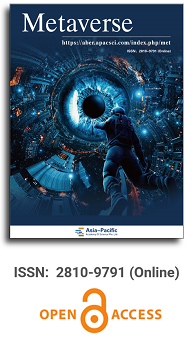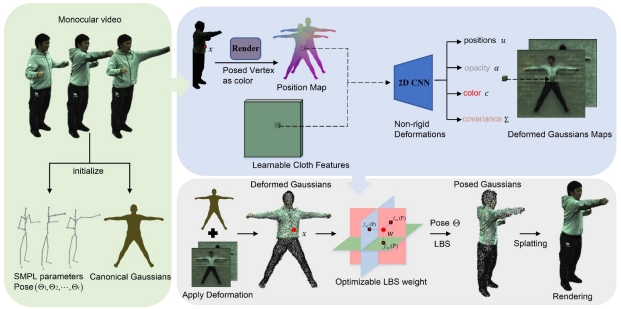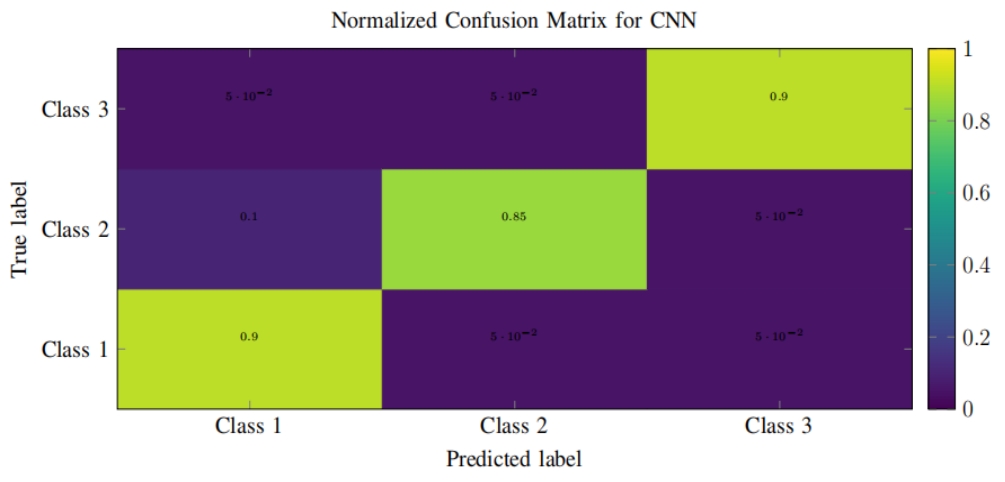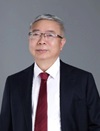
Asia Pacific Academy of Science Pte. Ltd. (APACSCI) specializes in international journal publishing. APACSCI adopts the open access publishing model and provides an important communication bridge for academic groups whose interest fields include engineering, technology, medicine, computer, mathematics, agriculture and forestry, and environment.



A survey on geometric shape representation of objects based on medial axis transform
Vol 4, Issue 1, 2023
Download PDF
Abstract
Geometric shape representation algorithms are key technologies in the fields of computer graphics and geometric modeling. The Medial Axis Transform (MAT) is an important geometric model description tool that provides a simplified representation of complex geometric shapes while ensuring accurate descriptions of geometric shape and topology. Therefore, it can meet the requirements of many modern research fields, including geometric modeling, pattern recognition, model segmentation, model deformation, physical simulation, path planning, and more. This paper first introduces the basic concept of the medial axis transform, including the definition of the medial axis transform and the concept of medial axis primitives. It then describes the extraction algorithms for the medial axis transform, specific research on the medial axis transform in computer vision and computer graphics, potential applications of the medial axis transform, and medial axis transform datasets. Finally, the disadvantages and advantages of the medial axis transform are discussed, and some suggestions on possible future research directions are presented.
Keywords
References
- Kreveld M, Oostrum R, Bajaj C, et al. Contour trees and small seed for isosurface traversal. International Symposium on Computational Geometry 1997; 212–220.
- Tarasov SP, Vyalyi MN. Construction of contour trees in 3D in O (n log n) steps. International Symposium on Computational Geometry 1998; 68–75.
- Au OKC, Tai CL, Chu HK, et al. Skeleton extraction by mesh contraction. ACM Transactions on Graphics 2008; 27(3): 1–10. doi: 10.1145/1360612.1360643.
- Ma WC, Wu FC, Ouhyoung M. Skeleton extraction of 3D objects with radial basis functions. In: 2003 Shape Modeling International; 2003 May 12–15; Seoul, Korea (South). New York: IEEE; 2003. p. 207–215. doi: 10.1109/SMI.2003.1199618.
- Blum H. A transformation for extracting new descriptors of shape. Models for Perception of Speech and Visual Forms 1967; 19(5): 362–380.
- Nackman LR, Pizer SM. Three-dimensional shape description using the symmetric axis transform I: Theory. IEEE Transactions on Pattern Analysis and Machine Intelligence 1985; 7(2): 187–202. doi: 10.1109/TPAMI.1985.4767643.
- Li P, Wang B, Sun F, et al. Q-mat: Computing medial axis transform by quadratic error minimization. ACM Transactions on Graphics (TOG) 2015; 35(1): 1–16. doi: 10.1145/2753755.
- Sonka M, Hlavac V, Boyle R. Image processing, analysis, and machine vision. Stamford: Cengage Learning; 2013. doi: 10.1007/978-1-4899-3216-7.
- Latombe JC. Robot motion planning. Norwell, MA, USA: Kluwer Academic Publishers; 1991.
- Dey T, Giesen J, Goswami S. Shape segmentation and matching with flow discretization. In: Dehne F, Sack JR, Smid M (editors). Proceedings of Algorithms and Data Structures. Springer Berlin Heidelberg; 2003.p. 25–36.
- Ogniewicz R. A multiscale mat from voronoi diagrams: The skeleton-space and its application to shape description and decomposition. Aspects of Visual Form Processing 1994; 430–439.
- Amenta N, Bern M. Surface Reconstruction by Voronoi Filtering. In: Proceedings of the Fourteenth Annual Symposium on Computational Geometry; 1998 Jun 7–10; Minneapolis Minnesota USA; New York, NY, USA: ACM; 1998. p. 39–48.
- Amenta N, Bern M, Eppstein D. The crust and the β-skeleton: Combinatorial curve reconstruction. Proceedings of Graphical Models and Image Processing 1998; 60(2): 125–135. doi: 10.1006/gmip.1998.0465.
- Price MA, Armstrong CG. Hexahedral mesh generation by medial surface subdivision: Part II. Solids with flat and concave edges. International Journal for Numerical Methods in Engineering 1997; 40(1): 111–136. doi: 10.1002/(SICI)1097-0207(19970115)40:1<111:AID-NME56>3.0.CO;2-K.
- Sheffer A, Etzion M, Rappoport A, et al. Hexahedral mesh generation using the embedded Voronoi graph. Engineering with Computers 1999; 15(3): 248–262. doi: 10.1007/s003660050020.
- Hisada M, Belyaev AG, Kunii TL. A Skeleton-based approach for detection of perceptually salient features on polygonal surfaces. Computer Graphics Forum 2002; 21(4): 689–700. doi: 10.1111/1467-8659.00627.
- Hoffmann CM. Geometric and solid modeling: An Introduction. San Francisco, CA, USA: Morgan Kaufmann Publishers Inc.; 1989.
- Siddiqi K, Pizer S. Medial representations: Mathematics, algorithms and applications. 1st ed. Berlin: Springer Publishing Company, Incorporated; 2008.
- Kazhdan M, Chazelle B, Dobkin D, et al. A reflective symmetry descriptor for 3D models. Algrithmica 2003; 38(1): 201–225. doi: 10.1007/s00453-003-1050-5.
- Siddiqi K, Zhang J, Macrini D, et al. Retrieving articulated 3-D models using medial surfaces. Machine Vision and Applications 2008; 19(4): 261–275. doi: 10.1007/s00138-007-0097-8.
- Pixologic. Zbrush [Internet]. [Cited 2023 Apr 20]. Available from: http://pixologic.com/zbrush/features/overview/.
- Ji Z, Liu L, Wang Y. B-Mesh: A modeling system for base meshes of 3D articulated shapes. Computer Graphics Forum 2010; 29(7): 2169–2177. doi: 10.1111/j.1467-8659.2010.01805.x.
- Thiery JM, GuyE, Boubekeur T. Sphere-Meshes: shape approximation using spherical quadric error metrics. ACM Transactions on Graphics (TOG) 2013; 32(6): 178. doi: 10.1145/2508363.2508384.
- Faraj N, Thiery JM, Boubekeur T. Progressive me-dial axis filtration. In: Proceedings of SIGGRAPH Asia 2013 Technical Briefs; 2013 Nov 19-22; Hongkong; New York, NY, USA: ACM; 2013: 3:1–4.
- Feng S, Yi K, Yu Y, et al. Medial meshes -- A compact and accurate representation of medial axis transform. IEEE Transactions on Visualization and Computer Graphics 2016; 22(3): 1278–1290.
- Lee DT. Medial axis transformation of a planar shape. IEEE Transactions on Pattern Analysis and Machine Intelligence 1982; 4(4): 363–369. doi: 10.1109/TPAMI.1982.4767267.
- Degen WLF. Exploiting curvatures to compute the medial axis for domains with smooth boundary. Computer Aided Geometric Design 2004; 21(7): 641–660. doi: 10.1016/j.cagd.2004.03.005.
- Aichholzer O, Aurenhammer F, Hackl T, et al. Computational and structural advantages of circular boundary representation. In: Proceedings of the 10th International Conference on Algorithms and Data Structures; 2007 Aug 15–17; Halifax, Canada; Heidelberg: Springer 2007. p. 374–385.
- Ma CM, Sonka M. A fully parallel 3D thinning algorithm and its applications. Computer Vision and Image Understanding 1996; 64(3): 420–433. doi: 10.1006/cviu.1996.0069.
- Brunner D, Brunnett G. Mesh segmentation using the object skeleton graph. In: Proceedings of the International Conference on Computer Graphics and Imaging 2004; 2004 Jul 26–29; Washington, USA. New York: IEEE; 2004. p. 48–55.
- Bertrand G, Couprie M. Powerful parallel and symmetric 3d thinning schemes based on critical kernels. Journal of Mathematical Imaging And Vision 2014; 48(1): 134–148. doi: 10.1007/s10851-012-0402-7.
- Borgefors G, Nystrom I, Baja GSD. Computing skeletons in three dimensions. Pattern Recognition 1999; 32(7): 1225–1236. doi: 10.1016/S0031-3203(98)00082-X.
- Lohou C, Bertrand G. A 3D 12-subiteration thinning algorithm based on p-simple points. Discrete Applied Mathematics 2004; 139(1–3): 171–195. doi: 10.1016/j.dam.2002.11.002.
- Xia H, Tucker PG. Fast equal and biased distance fields for medial axis transform with meshing in mind. Applied Mathematical Modelling 2011; 35(12): 5804–5819. doi: 10.1016/j.apm.2011.05.001.
- Song X, Jüttler B, Poteaux A. Hierarchical spline approximation of the signed distance function. In: Proceedings of the IEEE International Conference on Shape Modeling; 2010 Jun 21–23; Washington, USA. New York: IEEE; 2010. p. 241–245.
- Li M, Chen F, Wang W, Tu C. Sparse RBF surface representations. Computer Aided Geometric Design 2016; 48: 49–59. doi: 10.1016/j.cagd.2016.08.001.
- Schirmacher H, Zöckler M, Stalling D, et al. Boundary surface shrinking–A continuous approach to 3D center line extraction. Image & Multidimensional Digital Signal Processing 1998; 25–28.
- Bitter I, Kaufman AE, Sato M. Penalized-distance volumetric skeleton algorithm. IEEE Transactions on Visualization and Computer Graphics 2001; 7(3): 195–206. doi: 10.1109/2945.942688.
- Telea A, Vilanova A. A robust level-set algorithm for centerline extraction. In: Bonneau GP, Hahmann S, Hansen CD (editors). Proceedings of the Symposium On Data Visualization 2003; 2003 May 26–28; Grenoble. Goslar: Erographics Association; 2003. p. 185–194. doi: 10.5555/769922.769943.
- Couprie M, Zrour R. Discrete bisector function and euclidean skeleton. In: Andres E, Damiand G, Lienhardt P (editors). Proceedings of the 12th international conference on Discrete Geometry for Computer Imagery; 2005 Apr 13–15; Poitiers. Heidelberg: Springer-Verlag; 2005. p. 216–227. doi: 10.1007/978-3-540-31965-8_21.
- Attali D, Montanvert A. Computing and simplifying 2D and 3D continuous skeletons. Computer Vision and Image Understanding 1997; 67(3): 261–273. doi: 10.1006/cviu.1997.0536.
- Boissonnat JD. Geometric structures for three-dimensional shape representation. ACM Transactions on Graphics 1984; 3(4): 266–286. doi: 10.1145/357346.357349.
- Amenta N, Choi S, Kolluri RK. The power crust. In: Anderson DC, Lee K (editors). Proceedings of the sixth ACM symposium on Solid modeling and applications; 2001; Ann Arbor. New York: Association for Computing Machinery; 2001. p. 249–266. doi: 10.1145/376957.376986.
- Zhu Y, Sun F, Choi YK, Jüttler B, et al. Computing a compact spline representation of the medial axis transform of a 2D shape. Graph Models 2014; 76(5): 252–262. doi: 10.1016/j.gmod.2014.03.007.
- Wang J, Kosinka J, Telea AC. Splined-based medial axis transform representation of binary images. Computer & Graphics 2021; 98: 165–176. doi: 10.1016/j.cag.2021.05.012.
- Attali D, Montanvert A. Modeling noise for a better simplification of skeletons. In: Proceedings of 3rd IEEE International Conference on Image Processing; 1996 Sep 19; Lausanne. New York: IEEE; 1996. p. 13–16. doi: 10.1109/ICIP.1996.560357.
- Foskey M, Lin MC, Manocha D. Efficient computation of a simplified medial axis. In: Proceedings of the Eighth ACM Symposium on Solid Modeling And Applications; 2003 Jun 16–20; Washington, DC. New York: Association for Computing Machinery; 2003. p. 96–107. doi: 10.1145/781606.781623.
- Dey TK, Zhao W. Approximate medial axis as a voronoi subcomplex. In: Proceedings of the Seventh ACM Symposium on Solid Modeling And Applications; 2002 Jun 17–21; Saarbrücken. New York: Association for Computing Machinery; 2002. p. 356–366. doi: 10.1145/566282.566333.
- Sud A, Foskey M, Manocha D. Homotopy-preserving medial axis simplification. In: Proceedings of the 2005 ACM symposium on Solid and physical modeling; 2005 Jun 13–15; Massachusetts. New York: Association for Computing Machinery; 2005. p. 39–50. doi: 10.1145/1060244.1060250.
- Chazal F, Lieutier A. The “λ-medial axis”. Graphical Models 2005; 67(4): 304–331. doi: 10.1016/j.gmod.2005.01.002.
- Chaussard J, Couprie M, Talbot H. A discrete λ-medial axis. In: Brlek S, Reutenauer C, Provençal X (editors). Proceedings of the 15th IAPR International Conference on Discrete Geometry For Computer Imagery; 2009 Sep 30–Oct 2; Montréal. Heidelberg: Springer-Verlag; 2009. p. 421–433. doi: 10.5555/1813270.1813312.
- Chaussard J, Couprie M, Talbot H. Robust skeletonization using the discrete λ-medial axis. Pattern Recognition Letters 2011; 32(9): 1384–1394. doi: 10.1016/j.patrec.2010.09.002.
- Giesen J, Miklos B, Pauly M,Wormser C. The scale axis transform. In: Proceedings of the twenty-fifth annual symposium on Computational geometry; 2009 Jun 8–10; Aarhus. New York: Association for Computing Machinery; 2009. p. 106–115. doi: 10.1145/1542362.1542388.
- Miklos B, Giesen J, Pauly M. Discrete scale axis representations for 3D geometry. ACM Transactions on Graphics 2010; 29(4): 1–10. doi: 10.1145/1778765.1778838.
- Sun F, Choi YK, Yu Y, Wang W. Medial meshes for volume approximation. New York: arXiv; 2013. doi: 10.48550/arXiv.1308.3917.
- Yan Y, Sykes K, Chambers E, et al. Erosion thickness on medial axes of 3D shapes. ACM Transactions on Graphics 2016; 35(4): 1–12. doi: 10.1145/2897824.2925938.
- Pan Y, Wang B, Guo X, et al. Q-MAT+: An error-controllable and feature-sensitive simplification algorithm for medial axis transform. Computer Aided Geometric Design 2019; 71: 16–29. doi: 10.1016/j.cagd.2019.04.007.
- Rebain D, Angles B, Valentin J, et al. LSMAT least squares medial axis transform. Computer Graphics Fortum 2019; 38(6): 5–18. doi: 10.1111/cgf.13599.
- Wang N, Wang B, Wang W, Guo X. Computing medial axis transform with feature preservation via restricted power diagram. ACM Transactions on Graphics 2022; 41(6): 1–18. doi: 10.1145/3550454.3555465.
- Yan D, Lévy B, Liu Y, et al. Isotropic remeshing with fast and exact computation of restricted voronoi diagram. Computer Graphics Forum 2009; 28(5): 1445–1454. doi: 10.1111/j.1467-8659.2009.01521.x.
- Dou Z, Lin C, Xu R, et al. Coverage Axis: Inner point selection for 3D shape skeletonization. Computer Graphics Forum 2022; 41(2): 419–432. doi: 10.1111/cgf.14484.
- Yang B, Yao J, Guo X. DMAT: Deformable medial axis transform for animated mesh approximation. Computer Graphics Forum 2018; 37(7): 301–311. doi: 10.1111/cgf.13569.
- Hu J, Wang B, Qian L, et al. MAT-net: Medial axis transform network for 3D object recognition. In: Kraus S (editor). Proceedings of the 28th international joint conference on artificial intelligence; 2019 Aug 10–16; Macao. Washington, DC: AAAI Press; 2019. p. 774–781.
- Yin K, Huang H, Cohen-Or D, Zhang H. P2P-Net: Bidirectional point displacement net for shape transform. ACM Transactions on Graphics 2018; 37(4): 1–13. doi: 10.1145/3197517.3201288.
- Yang B, Yao J, Wang B, et al. P2MAT-NET: Learning medial axis transform from sparse point clouds. Computer Aided Geometric Design 2020; 80: 101874. doi: 10.1016/j.cagd.2020.101874.
- Lee Y, Baek J, Kim YM, Park FC. IMAT: The iterative medial axis transform. Computer Graphics Forum 2021; 40(6): 162–181. doi: 10.1111/cgf.14266.
- Su H, Maji S, Kalogerakis E, Learned-Miller E. Multi-view convolutional neural networks for 3D shape recognition. New York: arXiv; 2015. doi: 10.48550/arXiv.1505.00880.
- Wu Z, Song S, Khosla A, et al. 3D ShapeNets: A deep representation for volumetric shapes. New York: arXiv; 2015. doi: 10.48550/arXiv.1406.5670
- Qi CR, Su H, Mo K, Guibas LJ. PointNet: Deep learning on point sets for 3D classification and segmentation. New York: arXiv; 2017. doi: 10.48550/arXiv.1612.00593.
- Kimia BB. On the role of medial geometry in hu-man vision. Journal of Physiology-Paris 2003; 97(2–3): 155–190. doi: 10.1016/j.jphysparis.2003.09.003.
- Hung CC, Carlson ET, Connor CE. Medial axis shape coding in macaque inferotemporal cortex. Neuron 2012; 74(6): 1099–1113. doi: 10.1016/j.neuron.2012.04.029.
- Qi CR, Yi L, Su H, Guibas LJ. PointNet++: Deep hierarchical feature learning on point sets in a metric space. New York: arXiv; 2017. doi: 10.48550/arXiv.1706.02413.
- Chang AX, Funkhouser T, Guibas L, et al. ShapeNet: An information-rich 3D model repository. New York: arXiv; 2015. doi: 10.48550/arXiv.1512.03012.
- Choy CB, Xu D, Gwak JY, et al. 3D-R2N2: A unified approach for single and multi-view 3D object reconstruction. In: Leibe B, Matas J, Sebe N, Welling M (editors). 14th European conference on computer vision; 2016 Oct 8–16; Amsterdam. Cham: Springer Cham; 2016. p. 873. doi: 10.1007/978-3-319-46484-8_38.
- Tulsiani S, Zhou T, Efros AA, Malik J. Multi-view supervision for single-view reconstruction via differentiable ray consistency. New York: arXiv; 2017. doi: 10.48550/arXiv.1704.06254.
- Yamaguchi S, Saito S, Nagano K, et al. High-fidelity facial reflectance and geometry inference from an unconstrained image. ACM Transactions on Graphics 2018; 37(4): 1–14. doi: 10.1145/3197517.3201364.
- Varo G, Ceylan D, Russell B, et al. Bodynet: Volumetric inference of 3D human body shapes. New York: arXiv; 2018. doi: 10.48550/arXiv.1804.0487.
- Han X, Li Z, Huang H, et al. High-resolution shape completion using deep neural networks for global structure and local geometry inference. New York: arXiv; 2017. doi: 10.48550/arXiv.1709.07599.
- Yang Y, Feng C, Shen Y, et al. FoldingNet: Point cloud auto-encoder via deep grid deformation. In: Proceedings of the IEEE Conference on Computer Vision and Pattern Recognition (CVPR); 2021 Jun 20–25; Salt Lake City, UT, USA. New York: IEEE; 2018. p. 206–215.
- Fan H, Hao S, Guibas L. A point set generation network for 3D object reconstruction from a single image. In: 2017 IEEE Conference on Computer Vision and Pattern Recognition (CVPR); 2017 Jul 21–26; Honolulu, HI, USA. New York: IEEE; 2017. p. 2463–2471.
- Michalkiewicz M, Pontes JK, Jack D, et al. Implicit surface representations as layers in neural networks. In: 2019 IEEE/CVF International Conference on Computer Vision (ICCV); 2019 Oct 27–Nov 2; Seoul, Korea (South); Washington, USA. New York: IEEE; 2019. p. 4742–4751.
- Tang J, Han X, Pan J, et al. A skeleton-bridged deep learning approach for generating meshes of complex topologies from single rgb images. IEEE 2019; 4541–4550.
- Lin C, Li C, Liu Y, et al. Point2Skeleton: Learning skeletal representations from point clouds. In: Proceedings of the IEEE/CVF Conference on Computer Vision and Pattern Reconstruction(CVPR) 2021; 2021 Jun 19–25; Washington, USA. New York: IEEE; 2021. p. 4277–4286.
- Lorensen WE, Cline HE. Marching cubes: A high resolution 3D surface construction algorithm. ACM Siggraph Computer Graphics 1987; 21(4): 163–169. doi: 10.1145/37401.37422.
- Hu J, Chen G, Yang B, et al. IMMAT: Mesh reconstruction from single view images by medial axis transform prediction. Computer-Aided Design 2022; 150: 103304. doi: 10.1016/j.cad.2022.103304.
- Li C, Kim IY. Topology, size and shape optimization of an automotive cross car beam. Proceedings of the Institution of Mechanical Engineers, Part D: Journal of Automobile Engineering 2014; 229(10): 1361–1378. doi: 10.1177/0954407014561279.
- Wlodawer R. Directional solidification of steel castings. Oxford: Pergamon Press; 1966.
- Shahane S, Aluru N, Ferreira P, et al. Finite volume simulation framework for die casting with uncertainty quantification. Applied Mathematical Modelling 2019; 74: 132–150. doi: 10.1016/j.apm.2019.04.045.
- Sifakis E, Barbic J. FEM simulation of 3D deformable solids: A practitioner’s guide to theory, discretization and model reduction. ACM Siggraph 2012 Courses 2012; 20. doi: 10.1145/2343483.2343501.
- Pao W, Ransing R, Lewis R, Lin C. A medial-axes-based interpolation method for solidification simulation. Finite Elements in Analysis and Design 2004; 40(5–6): 577–593. doi: 10.1016/S0168-874X(03)00097-0.
- Ransing RS, Sood MP, Pao W. Computer implementation of Heuvers’ circle method for thermal optimisation in castings. International Journal of Cast Metals Research 2005; 18(2): 119–128. doi: 10.1179/136404605225022910.
- Sood MP. A novel geometry based approach for casting process optimisation [PhD thesis]. Swansea: Swansea University; 2006.
- Erber M, Rosnitschek T, Hartmann C, et al. Geometry-based assurance of directional solidification for complex topology-optimized casting using the medial axis transform. Computer Aided Design 2022 152: 103394. doi: 10.1016/j.cad.2022.103394.
- Funkhouser T, Kazhdan M, Shilane P, et al. Modeling by example. ACM Transactions on Graphics 2004; 23(3): 652–663. doi: 10.1145/1015706.1015775.
- Lin C, Fan T, Wang W, Nießner M. Modeling 3D shapes by reinforcement learning. New York: arXiv; 2020. doi: 10.48550/arXiv.2003.12397.
- Lévy B, Petitjean S, Ray N, et al. Least squares conformal maps for automatic texture atlas generation. ACM Transactions on Graphics 2002; 21(3): 362–371. doi: 10.1145/566654.566590.
- Hoffman DD, Richards WA. Parts of recognition. Readings in Computer Vision 1987; 227–242. doi: 10.1016/B978-0-08-051581-6.50028-3.
- Shapira L, Shamir A, Cohen-Or D. Consistent mesh partitioning and skeletonisation using the shape diameter function. Visual Computer 2008; 24(4): 249–259. doi: 10.1007/s00371-007-0197-5.
- Shu Z, Qi C, Xin S, et al. Unsupervised 3D shape segmentation and co-segmentation via deep learning. Computer Aided Geometric Design 2016; 43: 39–52. doi: 10.1016/j.cagd.2016.02.015.
- Kaick OV, Fish N, Kleiman Y, et al. Shape segmentation by approximate convexity analysis. ACM Transactions on Graphics 2014; 34(1): 4. doi: 10.1145/2611811.
- Lin C, Liu L, Li C, et al. SEG-MAT: 3D shape seg-mentation using medial axis transform. IEEE Transactions on Visualization and Computer Graphics 2022; 28(6): 2430–2444. doi: 10.1109/TVCG.2020.3032566.
- Adams R, Bischof L. Seeded region growing. IEEE Transactions on Pattern Analysis and Machine Intelligence 1994; 16(6): 641–647. doi: 10.1109/34.295913.
- Rubner Y, Tomasi C, Guibas LJ. The Earth Mover’s Distance as a metric for image retrieval. International Journal of Computer Vision 2000; 40(2): 99–121.
- Delong A, Osokin A, Boykov IY. Fast approximate energy minimization with label costs. International Journal of Computer Vision 2012; 96: 1–27. doi: 10.1007/s11263-011-0437-z.
- Lan L, Luo R, Fratarcangeli M, et al. Medial elastics: Efficient and collision-ready deformation via medial axis transform. ACM Transactions on Graphics 2020; 39(3): 20. doi: 10.1145/3384515.
- Pabst S, Koch A, Straßer W. Fast and scalable CPU/GPU collision detection for rigid and deformable surfaces. Computer Graphics Forum 2010; 29(5): 1605–1612. doi: 10.1111/j.1467-8659.2010.01769.x.
- Brandt C, Eisemann E, Hildebrandt K. Hyper-reduced projective dynamics. ACM Transactions on Graphics 2018; 37(4): 80. doi: 10.1145/3197517.3201387.
- Lan L, Yang Y, Kaufman DM, et al. Medial IPC. ACM Transactions on Graphics 2021; 40(4): 1–16. doi: 10.1145/3450626.3459753.
- Li M, Ferguson Z, Schneider T, et al. Incremental potential contact: Intersection- and inversion- free, large-deformation dynamics. ACM Transactions on Graphics 2020; 39(4): 49. doi: 10.1145/3386569.3392425.
- Song S, Lan L, Yao J, et al. Continuous collision detection with medial axis transform for rigid body simulation. Communications in Information and Systems 2022; 22(1): 53–78. doi: 10.4310/CIS.2022.v22.n1.a3.
- Lan L, Yao J, Huang P, Guo X. Medial-axis-driven shape deformation with volume preservation. The Visual Computer 2017; 33(6–8): 789–800. doi: 10.1007/s00371-017-1401-x.
Supporting Agencies
Copyright (c) 2023 Junfeng Yao, Hanyin Zhang, Xingxin Li, Mengyuan Ge, Weixing Xie, Yong Yang

This work is licensed under a Creative Commons Attribution 4.0 International License.

This site is licensed under a Creative Commons Attribution 4.0 International License (CC BY 4.0).

Prof. Zhigeng Pan
Professor, Hangzhou International Innovation Institute (H3I), Beihang University, China

Prof. Jianrong Tan
Academician, Chinese Academy of Engineering, China
Conference Time
December 15-18, 2025
Conference Venue
Hong Kong Convention and Exhibition Center (HKCEC)
...
Metaverse Scientist Forum No.3 was successfully held on April 22, 2025, from 19:00 to 20:30 (Beijing Time)...
We received the Scopus notification on April 19th, confirming that the journal has been successfully indexed by Scopus...
We are pleased to announce that we have updated the requirements for manuscript figures in the submission guidelines. Manuscripts submitted after April 15, 2025 are required to strictly adhere to the change. These updates are aimed at ensuring the highest quality of visual content in our publications and enhancing the overall readability and impact of your research. For more details, please find it in sumissions...






.jpg)
.jpg)

